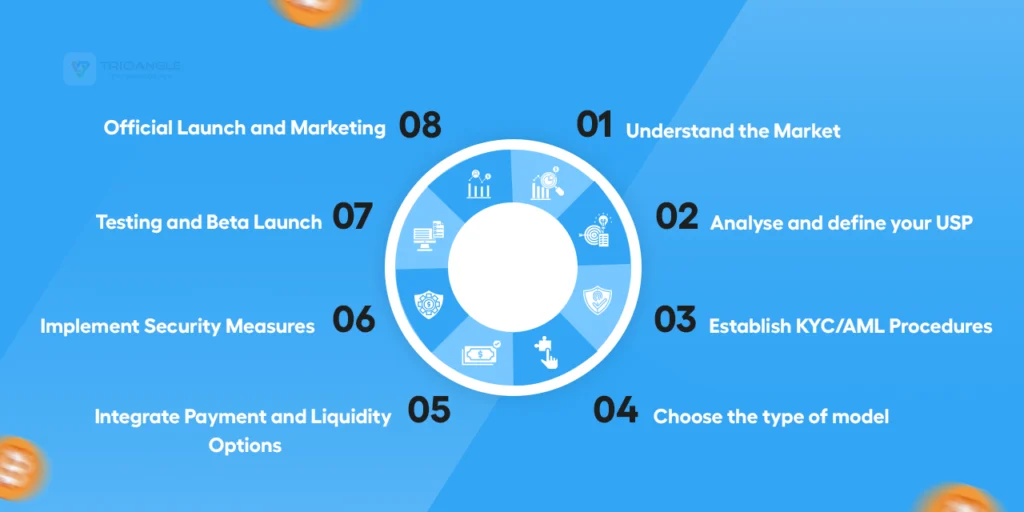If you’re thinking about how to create a cryptocurrency exchange platform, this article is for you.
Which cryptocurrency exchange is best?
Many users have been pondering over this question. There are countless crypto exchanges emerging every day. But still the need for the best platform exists.
Do you know why?
It’s simple. Because not all crypto exchange platforms are built right. Digital currencies are shifting from hype to infrastructure. It’s been pointless of people saying, “crypto is the future”. I don’t agree with that. Evolution and utilization of crypto has started and is making its mark so strong.
If you’ve been still delving here, Kudos to your bold move. You’ve decided to create cryptocurrency exchange.
But the real challenge? Doing it right.
This guide is your complete roadmap to launching a crypto exchange that meets today’s market demands. Also, you’ll know how cryptocurrency exchange development company and services play a key role in the creation of crypto exchanges.
Let’s start with why.
Why Build a Crypto Exchange in 2025?
Statista’s 2024 Q4 crypto report also shows a 17% YoY increase in exchange usage. Binance, Coinbase, and Kraken handle over 70% of daily crypto trade volumes. The Central African Republic has legalized Bitcoin as legal tender. Meanwhile, decentralized finance (DeFi) and NFTs continue to boom, driving further interest in crypto trading.
According to a recent Forbes report, the number of active cryptocurrency users globally is expected to exceed 1 billion by the end of 2025.
Institutional investors are pouring billions into the crypto market. With emerging economies exploring central bank digital currencies (CBDCs), the appetite for trading infrastructure is enormous.
So, if you’ve been contemplating how to create a crypto exchange platform, there’s no better time than now.
Let’s discuss the types of cryptocurrency exchanges.
Types of Cryptocurrency Exchanges
Before diving into the technical, you need to decide on the type of exchange you want to create.
- Centralized Exchange (CEX): These are managed by a central authority. Examples include Binance and Coinbase which are best cryptocurrency exchange for USA. They offer high liquidity and user-friendly interfaces.
- Decentralized Exchange (DEX): These operate without intermediaries. It’s a cryptocurrency exchange without KYC. Platforms like Uniswap and PancakeSwap are powered by smart contracts. They attract users who prefer privacy and control over their assets.
- Hybrid Exchange: Combining the best of CEX and DEX, hybrid exchanges aim to offer high liquidity with decentralized security.
It’s the first step when deciding how to build a cryptocurrency exchange platform. Always start by identifying which model fits your business goals and target audience.
Now, we can delve into the technical side.
Technical Architecture of a Crypto Exchange Platform
Here’s a breakdown of the essential components to develop and start your cryptocurrency exchange platform. These will help you to be on the best cryptocurrency exchanges in the united states.
1. Frontend (User Interface)
- Web & mobile responsive design
- Easy onboarding, KYC/AML integration
- Trading dashboard with real-time charts
2. Backend (Server-Side Logic)
- Matching engine: Matches buy and sell orders
- Wallet management: Secure hot and cold wallets
- Transaction processing: Ensures speed and accuracy
- API integration: For third-party services and liquidity aggregation
3. Blockchain Integration
- Nodes setup for Bitcoin, Ethereum, and other popular coins
- Smart contract deployment for DEX functionalities
4. Security Infrastructure
- 2FA and biometric logins
- Anti-phishing mechanisms
- Withdrawal whitelist
- Device management
- Account timeout
- Cold wallet storage and multi-signature authorization
5. Admin Panel
- User management
- Trade monitoring & analytics
- Commission and revenue tracking
- Profit management
Success in constructing a cryptocurrency exchange requires proper implementation of a technological stack which guarantees both scalability and security. I’m listing out widely used technology tools for cryptocurrency exchange development. It consists of React or Angular for frontend work. And Node.js or Django for backend with PostgreSQL or MongoDB for database management.
Time to build your cryptocurrency exchange has just begun
Step-by-Step Guide on how to create a Cryptocurrency Exchange

Explore these 8 steps to make your cryptocurrency exchange best.
Step #1: Define Your Business Model
Understanding your target market and services is crucial. This is the first step on starting your cryptocurrency exchange platform. Decide what you need to focus on.
- Spot Trading: Direct buying/selling of crypto assets. Suitable for beginners and retail users.
- Margin Trading: Allows users to trade with leverage, increasing both potential profit and risk.
- Derivatives and Futures: Advanced financial instruments, suitable for seasoned traders.
- Staking and Lending: Provide DeFi-style options to attract passive income seekers.
Your business model will influence the platform’s architecture, compliance requirements, and liquidity needs.
Step #2: Conduct Market Research
- Analyze Competitors: Study features offered by exchanges like Binance, Kraken, and Bybit.
- Identify Market Gaps: Look for under-served regions or niches (e.g., a local currency pair or a low-fee structure).
- Define Your USP (Unique Selling Proposition): Define whether you’re going to be the crypto exchange with lowest fees. Fastest transaction speeds or access to unique or new tokens.
Understanding user pain points and delivering what others don’t is key to thriving.
Step #3: Regulatory Compliance
Are crypto exchanges regulated? This is the one of the things your users look to feel safe. This is where most entrepreneurs face roadblocks.
- USA: Register with FinCEN as a Money Services Business (MSB). Comply with the Bank Secrecy Act (BSA).
- EU: Follow the MiCA regulation (Markets in Crypto-Assets). GDPR compliance for user data is also required.
- Asia: Japan requires registration with the FSA (Financial Services Agency). Singapore mandates licensing under the Payment Services Act by MAS.
Work with legal consultants to
- Draft Terms of Service and Privacy Policies
- Establish KYC/AML processes
- Set up ongoing audit mechanisms
Step #4: Hire Developers or Use White-Label Solutions
- Custom Development: Gives you full control over features, branding, and scalability. Suitable if you have funding and technical leadership.
- White-Label Solutions: Cost-effective and fast to deploy. Helps you launch your platform with inbuilt features.
Ensure your developers understand blockchain development, cybersecurity, and exchange logic. A reputed cryptocurrency exchange development company helps you create your desired crypto exchange platform leaving no stones unturned.
Step #5: Integrate Payment Gateways and Liquidity Providers
You should know how to make a cryptocurrency exchange comfortable for users. Making your crypto exchange available to users is also something you need to focus on.
- Payment Gateways: Support fiat-to-crypto, crypto-to-fiat, and crypto-to-crypto conversion. Services like MoonPay, Simplex, and Mercuryo can facilitate credit/debit card transactions.
- Liquidity Providers: Aggregating liquidity from multiple exchanges improves trading depth and order fulfillment. Use APIs from Binance, Huobi, or aggregated liquidity pools.
Integrating region-specific payment helps you put among the largest cryptocurrency exchanges in the United States. Creating a crypto exchange wallet on your platform can help users to trade instantly.
Step #6: Implement Security Protocols
Security is the backbone of any crypto exchange. Implement You need to create a cryptocurrency exchange with layered security protocols. It ensures your platform stands strong against any unexpected threats.
- Multi-layered authentication (2FA, biometrics)
- Cold storage
- Anti-phishing Measures
- Account Activity and Deletion
- Withdrawal Security
- DDoS mitigation tools
- Smart contract audits (for DEX/hybrid models)
Protecting user’s funds and data is quintessential. It brings reputation to your platform. And also boosts trust among your users.
Step #7: Launch Beta and Collect Feedback
- Develop an MVP with essential features: user signup, wallet, trading interface, order book.
- Invite real users to participate in closed beta testing.
- Monitor usage patterns and gather feedback on UX, latency, order execution, and bug reports.
- Improve UI/UX, backend processes, and performance.
Step #8: Official Launch with Marketing & SEO
- Perform an SEO audit and optimize it
- Use Crypto Influencers on YouTube/Twitter. Telegram/Discord communities for buzz. Press releases and guest blogs on CoinDesk, CoinTelegraph, and Hackernoon
A powerful go-to-market strategy can define your exchange’s early success. If you still have questions in mind, feel free to check out here.
Costs Involved in Building a Crypto Exchange
- Development from scratch: $50,000 – $500,000+
- Licensing & legal: $20,000 – $100,000
- Security setup: $10,000 – $50,000
- Marketing & SEO: $5,000 – $50,000
Generally, creating a crypto exchange costs start from a moderate range of about 10-12,000 USD. While these numbers might seem steep, ROI is substantial. The average daily revenue for mid-sized exchanges ranges from $10,000 to $200,000.
Countdown for creating your Cryptocurrency Exchange starts
Current Trends and the Future of Crypto Exchanges
Some major trends shaping how to build cryptocurrency exchange platforms in 2025 include
- AI-Powered Trading Bots: Platforms like Pionex are gaining traction
- Cross-Chain Swaps: Enabled by protocols like THORChain
- NFT Market Integration: Letting users trade NFTs on the same exchange
- RegTech Automation: Compliance-as-a-service to meet global regulations
Governments are also stepping up oversight. New AML directives in the EU will require full KYC for even decentralized protocols. You can also make your crypto exchange with lowest fees to attract more traders. Analysing top cryptocurrency exchange development trends is necessary for creating a future-ready platform.
I really appreciate your patience for understanding and digesting my insights. We’ve reached the end of the blog. Read it out to find out what’s behind it.
Conclusion: Build the Future of Finance
The digital currency system already exists in the current era. Learning cryptocurrency exchange website development positions you as a leader in the financial revolution. The difficulties which technical and regulatory requirements cannot be ignored. However, they remain solvable obstacles.
You need to choose between starting a cryptocurrency exchange platform either with a custom-built solution or a white-label license. Both are crucial in the present market conditions. The path to success in crypto business development relies on current trends, regulated operations and user-friendly secure systems. Teaming up with a cryptocurrency exchange development company like us makes your business entry process smoother and faster.
The comprehensive guide you seek regarding cryptocurrency exchange development is in your hands. You no longer need to worry about how to build cryptocurrency exchange platform. Build the base of your surfboard rather than merely participate in the cryptocurrency trends. The process to establish a crypto exchange platform includes building a cryptocurrency exchange alongside arranging for a cryptocurrency exchange platform construction. Follow this guide and make yours the best cryptocurrency exchanges in United States and beyond.
Still here? It’s time to turn creating your cryptocurrency exchange idea into reality.


![The Truth About AI Powered Centralized Crypto Exchanges [Proven Results]](http://www.trioangle.com/blog/wp-content/uploads/2025/08/The-Truth-About-AI-Powered-Centralized-Crypto-Exchanges-440x247.webp)


